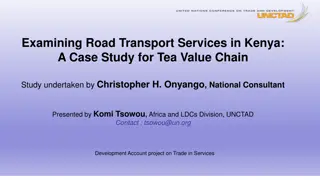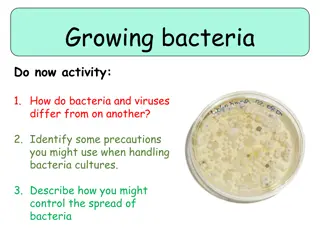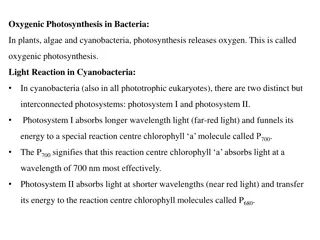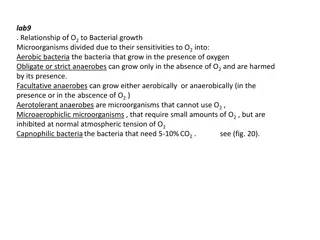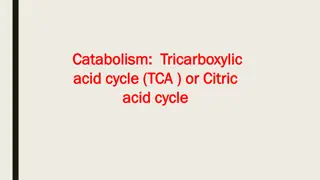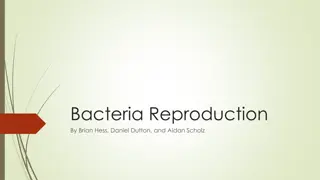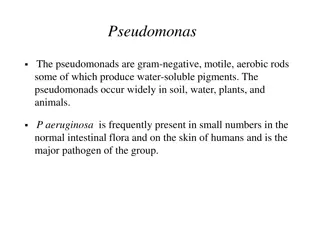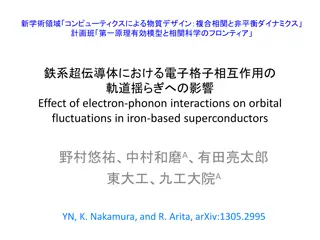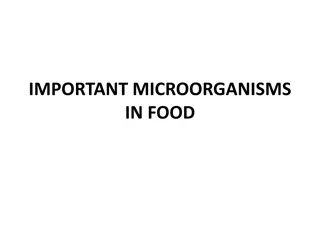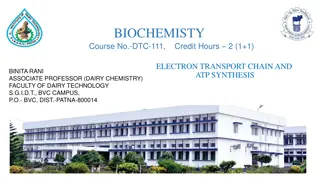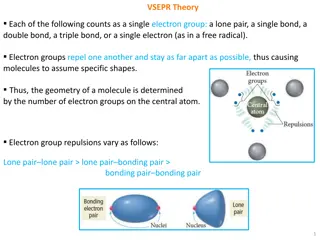Understanding the Electron Transport Chain in Bacteria
The electron transport chain in bacteria plays a crucial role in generating additional ATP by oxidative phosphorylation. It involves the transfer of electrons from NADH and FADH2 to oxygen through a series of membrane-associated electron carriers. The chemiosmotic theory explains how this process functions across different cell types, creating a proton motive force that drives ATP synthesis via ATP synthase complexes. This energy conversion mechanism is essential for cellular respiration and energy production.
Download Presentation

Please find below an Image/Link to download the presentation.
The content on the website is provided AS IS for your information and personal use only. It may not be sold, licensed, or shared on other websites without obtaining consent from the author. Download presentation by click this link. If you encounter any issues during the download, it is possible that the publisher has removed the file from their server.
E N D
Presentation Transcript
During various steps in glycolysis and the citric acid cycle, the oxidation of certain intermediate precursor molecules causes the reduction of NAD+ to NADH + H+ and FAD to FADH2. NADH and FADH2 then transfer protons and electrons to the electron transport chain to produce additional ATPs by oxidative phosphorylation . During the process of aerobic respiration, coupled oxidation-reduction reactions and electron carriers are often part of what is called an electron transport chain , a series of electron carriers that eventually transfers electrons from NADH and FADH2 to oxygen. The diffusible electron carriers NADH and FADH2 carry hydrogen atoms (protons and electrons) from substrates in exergonic catabolic pathways such as glycolysis and the citric acid cycle to other electron carriers that are embedded in membranes. These membrane-associated electron carriers include flavoproteins, iron-sulfur proteins, quinones, and cytochromes. The last electron carrier in the electron transport chain transfers the electrons to the terminal electron acceptor, oxygen.
The chemiosmotic theory explains the functioning of electron transport chains. According to this theory, the transfer of electrons down an electron transport system through a series of oxidation-reduction reactions releases energy . This energy allows certain carriers in the chain to transport hydrogen ions (H+ or protons) across a membrane. Depending on the type of cell, the electron transport chain may be found in the cytoplasmic membrane or the inner membrane of mitochondria. In prokaryotic cells, the protons are transported from the cytoplasm of the bacterium across the cytoplasmic membrane to the periplasmic space located between the cytoplasmic membrane and the cell wall . In eukaryotic cells, protons are transported from the matrix of the mitochondria across the inner mitochondrial membrane to the intermembrane space located between the inner and outer mitochondrial membranes
ATP Synthase Generating ATP (The chemiosmotic theory) It explains the functioning of electron transport chains. According to this theory, the tranfer of electrons down an electron transport system through a series of oxidation-reduction reactions releases energy. This energy allows certain carriers in the chain to transport hydrogen ions (H+ or protons) across a membrane. As the hydrogen ions accumulate on one side of a membrane, the concentration of hydrogen ions creates an electrochemical gradient or potential difference (voltage) across the membrane. The fluid on the side of the membrane where the protons accumulate acquires a positive charge; the fluid on the opposite side of the membrane is left with a negative charge. The energized state of the membrane as a result of this charge separation is called proton motive force or PMF. This proton motive force provides the energy necessary for enzymes called ATP synthases, also located in the membranes mentioned above, to catalyze the synthesis of ATPfrom ADP and phosphate. This generation of ATP occurs as the protons cross the membrane through the ATP synthase complexes and re-enter either the bacterial cytoplasm or the matrix of the mitochondria. As the protons move down the concentration gradient through the ATP synthase, the energy released causes the rotor and rod of the ATP synthase to rotate. The mechanical energy from this rotation is converted into chemical energy as phosphate is added to ADP tform ATP.
The electron transport chains of bacteria (prokaryotes) operate in plasma membrane (mitochondria are absent in prokaryotes). Some bacterial electron transport chains resemble the mitochondrial electron transport chain. Paracoccus denitrificans is a gram-negative, facultative anaerobic soil bacterium. It is a model prokaryote for studies of respiration. When this bacterium grows aerobically, its electron transport chain possesses four complexes that correspond to the mitochondrial chain. But, when this bacterium grows anaerobically with nitrate as its electron acceptor, the chain is structured quite differently. Since most bacteria grow anaerobically using different variety of electron acceptor substances, the bacterial electron transport chains are frequently very different.
Bacterial electron transport chains vary in their electron carriers (e.g., in their cytochromes) and are usually extensively branched. Electrons often enter at several points and leave through several terminal oxidases. Bacterial electron transport chains are usually shorter and possess lower phosphorus to oxygen (P/O) ratios than mitochondrial transport chain. Thus bacterial (prokaryotic) and mitochondrial (eukaryotic) electron transport chains differ in details of construction although they operate employing the same fundamental principles.





